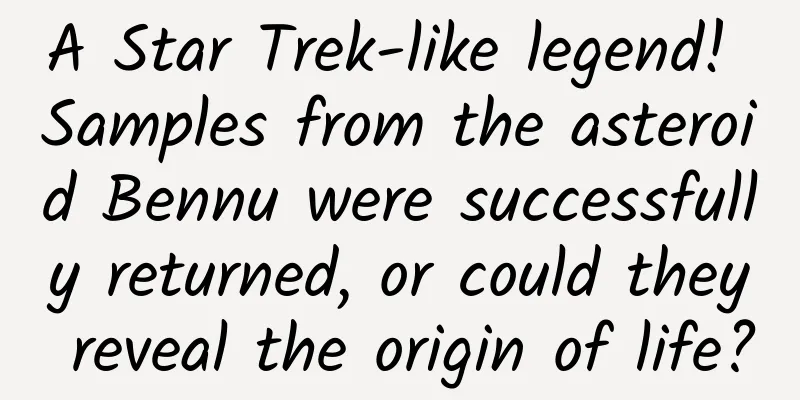A Star Trek-like legend! Samples from the asteroid Bennu were successfully returned, or could they reveal the origin of life?

|
Digging "soil" from outer space to draw a portrait of the "infancy" of the solar system When the return capsule penetrated the clouds like a flying saucer, the red and white parachute quickly deployed. After seven years, the asteroid sampling probe "OSIRIS-REx" (Pluto) arrived as promised with a handful of new "soil". At 10:52 a.m. Eastern Time on September 24, the return capsule carrying samples from the surface of the asteroid "Bennu" successfully landed in a desert near Salt Lake City, Utah, USA. The sample capsule was then transported by helicopter to a temporary "clean room" to prevent contamination by materials on Earth. Pluto was launched on September 8, 2016, and arrived near Bennu on December 3, 2018. On October 20, 2020, Pluto used a robotic arm to collect rock and dust samples on the surface of Bennu in a "grab and go" manner. On May 10, 2021, Pluto embarked on its journey back to Earth. Bennu is like a "time capsule" Bennu is a near-Earth asteroid with a diameter of about 500 meters. It was discovered in 1999 and approaches the Earth once every six years. Near-Earth asteroids are generally naughty and pass by the Earth from time to time, and even occasionally hit the Earth. Scientists believe that some carbonaceous asteroids hit the Earth in the early days of the Earth's formation and brought substances such as water. Therefore, its interior may contain the earliest mineral information of the solar system and may even reveal the mystery of the origin of life. "Bennu is more than 4.5 billion years old. It is a carbonaceous asteroid that contains water and organic matter. Its components have not undergone drastic evolution, which means that the material inside it still retains the state at the beginning of the formation of the solar system." Ji Jianghui, a researcher at the Purple Mountain Observatory of the Chinese Academy of Sciences and director of the Key Laboratory of Planetary Science of the Chinese Academy of Sciences, told the Popular Science Times reporter that asteroids like Bennu are like "time capsules" in the universe. Studying them can provide insight into the "infant" solar system, and may even help humans find clues to the origin of life on Earth. Liu Yujuan, a researcher at the National Astronomical Observatory, mentioned in an article that all life forms on Earth are based on carbon atom chains and molecules combined with elements such as oxygen, hydrogen, and nitrogen. However, scientists hope to find organic matter that does not belong to traditional biology in Bennu's samples to help scientists further understand the role of carbon-containing asteroids in the origin of life on Earth. Sampling in the Arctic is more "primitive" Pluto spent two years flying around Bennu and eventually chose to land in the "Nightingale" sampling area. On October 20, 2020, during an activity that lasted about four and a half hours, the Pluto, which is the size of a large van, approached Bennu at a slow speed of 300 meters per hour, and stayed for 5 seconds after landing to collect debris. What the Pluto project team did not expect was that they found the surface of the asteroid was covered with dense small rocks. "The best sampling area should be flat and smooth to facilitate the robotic arm to collect samples." Ji Jianghui said that the probe will hit the asteroid with the sampling head, mainly using nitrogen to blast the surface debris. The role of nitrogen is to lift the material to be sucked into the sampler. The surface of the asteroid has almost no gravity, so the probe can only choose the "take and go" method to collect samples. In addition, Nightingale is very close to Bennu's north pole, where the temperature is relatively low. Therefore, the soil and gravel here are less eroded than the materials near the equator of the asteroid, increasing the probability of collecting original organic matter and water-containing minerals. Next stop: Apophis According to a plan announced by the National Aeronautics and Space Administration (NASA), 25% of these samples will be sent to about 200 scientists from various countries for research in the next two years, and the rest may be stored for decades. After sending samples from the asteroid Bennu back to Earth, the Pluto spacecraft has not ended its mission and will continue to fly to the asteroid Apophis. Ji Jianghui revealed that Apophis, with an average diameter of about 370 meters, is also a near-Earth asteroid. It is not small in size, and its orbit intersects with the Earth's orbit. It is also an asteroid that poses a potential threat to the Earth. According to NASA's official website, the asteroid Apophis is a rocky asteroid. Pluto's close-up detection of Apophis can help scientists gain a deeper understanding of the surface and internal properties of "potentially threatening asteroids", and better understand the similarities and differences between carbonaceous and rocky asteroids. "China plans to launch the Tianwen-2 probe in 2025 to collect and return samples from a near-Earth asteroid named '2016HO3'. This will be the first time that China has retrieved samples from an interplanetary object." Ji Jianghui said he looks forward to more surprises about the "time capsule" being delivered to Earth. (Science Popularization Times reporter Shi Qi) |
Recommend
Thyroid cancer is becoming more and more common. What should you eat after surgery?
The thyroid gland is the largest endocrine organ ...
How much does it cost to develop the Jinchang wine and beverage mini program? Jinchang wine and beverage applet development price inquiry
The main factors affecting the price of mini prog...
Mazda, the BMW of Japan, may still have a chance to save itself in fuel vehicles
Mazda is known as the BMW of Japan. But when BMW ...
How much does it cost to build an app platform?
We have mentioned before why more and more people...
I was bitten by a snake! What should I do? What should I do?
Life is not just about the immediate, but also ab...
Han Yibing: 2016 will see a huge explosion in Internet TV advertising, and brands should plan ahead
On October 19, 2015, the 2015 China Internet TV D...
What are some common problems you may encounter in website maps?
Friends who do website SEO optimization may be fa...
Kuaishou Brand Self-broadcasting Methodology
Branded self-broadcasting is undoubtedly the hott...
A must-have course for counselors: DSM-5 and the Diagnostic Interview for Mental Disorders | A series of 17 videos with 11 real cases to teach you how to make a diagnosis video course
An essential course for counselors: DSM-5 and Diag...
Does eating leftover rice and vegetables cause cancer? Can we still eat them? One article explains
Author | Xue Qingxin, registered nutritionist, re...
Event Promotion: How to do a good job in event review?
Since last year, I have started to learn how to r...
Case analysis: Uncovering the growth model of Zebra AI class’s 0-yuan traffic diversion course
Zebra AI Class is an intelligent education platfo...
Red alert, severe flood! The highest water level ever measured!
Starting from the early morning of June 21, Yingd...
How to increase followers through Luckin Coffee’s coupon event!
Will Luckin Coffee become the next ofo? Luckin Co...
How much does it cost to develop the Wenshan bargaining app? How much does it cost to develop the Wenshan bargaining mini program?
The main factors affecting the price of mini prog...



![A Chinese team changes the world again! iOS9 can be jailbroken [Download]](/upload/images/67ebe2d9cb092.webp)





